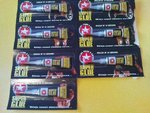mandoman
Airman 1st Class
Right now I'm finishing up on a 1/48 Mitsubishi "Dinah" Ki-46. I really thought I had got this one right. I only broke a couple of parts that were easily repaired, and the canopy masking seemed like the best I had yet accomplished......until I started removing the masking after all else was complete. Crap, I have GOT to figure out how to mount, mask, and paint a canopy correctly. At this point, I don't really care about the rest of it, but I want that canopy to look good, because it tends to be the most noticeable part on the aircraft. I think so, anyway. The main problem I have is the plastic deforms along the base of the canopy, and though I think I'm smoothing it out, I always find out AFTER I paint that it isn't smooth at all. I must be blind, AND dumb.
Any of you have any tricks on mounting canopies neatly, or am I just stupid?
Any of you have any tricks on mounting canopies neatly, or am I just stupid?


